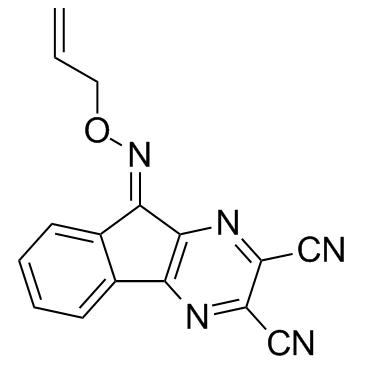
USP8-IN-22c
CAS No. 924296-17-3
USP8-IN-22c( —— )
Catalog No. M16621 CAS No. 924296-17-3
A potent, selective ubiquitin-specific protease USP8 inhibitor with IC50 of 0.56 uM.
Purity : >98% (HPLC)
 COA
COA
 Datasheet
Datasheet
 HNMR
HNMR
 HPLC
HPLC
 MSDS
MSDS
 Handing Instructions
Handing Instructions
| Size | Price / USD | Stock | Quantity |
| 2MG | 178 | Get Quote |


|
| 5MG | 309 | Get Quote |


|
| 10MG | 441 | Get Quote |


|
| 25MG | 705 | Get Quote |


|
| 50MG | 981 | Get Quote |


|
| 100MG | 1332 | Get Quote |


|
| 500MG | 2655 | Get Quote |


|
| 1G | Get Quote | Get Quote |


|
Biological Information
-
Product NameUSP8-IN-22c
-
NoteResearch use only, not for human use.
-
Brief DescriptionA potent, selective ubiquitin-specific protease USP8 inhibitor with IC50 of 0.56 uM.
-
DescriptionA potent, selective ubiquitin-specific protease USP8 inhibitor with IC50 of 0.56 uM; shows no inhibitory activity for USP7, USP5, SENP1, Uch-L3, and caspase 3 (IC50>100 uM), and displays partial activity against Uch-L3; inhibits the viability of HCT116 colon and PC-3 prostate cancer cell lines with IC50 values in the 0.5-1.5 uM range.
-
In Vitro——
-
In Vivo——
-
Synonyms——
-
PathwayProteasome/Ubiquitin
-
TargetDUB
-
RecptorDUB
-
Research AreaCancer
-
Indication——
Chemical Information
-
CAS Number924296-17-3
-
Formula Weight287.2756
-
Molecular FormulaC16H9N5O
-
Purity>98% (HPLC)
-
SolubilityDMSO: 20.1 mg/mL
-
SMILESC=CCON=C1C2=CC=CC=C2C3=NC(=C(N=C31)C#N)C#N
-
Chemical Name9H-Indeno[1,2-b]pyrazine-2,3-dicarbonitrile, 9-[(2-propen-1-yloxy)imino]-
Shipping & Storage Information
-
Storage(-20℃)
-
ShippingWith Ice Pack
-
Stability≥ 2 years
Reference
1. Colombo M, et al. ChemMedChem. 2010 Apr 6;5(4):552-8.
molnova catalog



related products
-
USP30 inhibitor 11
USP30 inhibitor 11 (USP30-IN-11) is a selective USP30 inhibitor (IC50: 0.01 μΜ) that inhibits SVA and can be used in studies of cancer, mitochondrial dysfunction and Parkinson's.
-
MK8745
MK-8745 is a potent and selective Aurora A inhibitor.
-
B-AP15
B-AP15(NSC687852) is a specific inhibitor of the deubiquitinating enzymes UCHL5 and Usp14 of the 26S proteasome.



 Cart
Cart
 sales@molnova.com
sales@molnova.com


